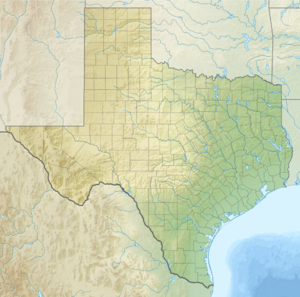Caddo Lake State Park
| Caddo Lake State Park | |
| Texas State Park | |
|
Caddo Lake viewed from a point near Uncertain
|
|
| Name origin: Named for the Caddo Indians, who inhabited the area | |
| Country | United States |
|---|---|
| State | Texas |
| Region | East Texas |
| District | Harrison County |
| Municipality | Karnack |
| Location | Karnack |
| - elevation | 237 ft (72 m) |
| - coordinates | 32°41′27″N 094°10′45″W / 32.69083°N 94.17917°WCoordinates: 32°41′27″N 094°10′45″W / 32.69083°N 94.17917°W |
| Area | 468 acres (189 ha) |
| Biome | Wetlands, freshwater |
| Founded | June 1933 |
| Management | Texas Parks and Wildlife Department |
| IUCN category | IV - Habitat/Species government Area |
| Website: Caddo Lake State Park | |
Caddo Lake State Park is a state park located in eastern Texas. Caddo Lake, the lake that the state park encompasses, is one of only a handful of natural lakes in Texas. The park consists of 8,253 acres (3,340 ha) west of the lake itself, in Harrison County, near Karnack, Texas. The lake and surrounding area was drilled for petroleum in the 1900s. The lake was created by a gigantic log jam known as the Great Raft.
The first humans settled in the area near the park around 10,000 BC. For several centuries, these people used the marshlands of Caddo Lake to gather food. Sometime around 800 AD, the first Caddo settlements appeared in the area. At the time, the tribes in the region were not a connected nation, instead being a large collection of close-knit, peaceful gathering communities. Over time, the Caddo communities grew and prospered, becoming a highly farming community by at least 1200 AD, learning to grow crops such as maize (corn).
In 1542, the Francisco de Soto expedition, led by Luis de Moscoso Alvarado due to De Soto's death earlier in the expedition, discovered the complex Caddoan society. They sent back the first descriptions of the Caddo. Several more European expeditions explored the area around the park throughout the 1600s. The Spanish established several Missions and trading-posts during the 1700s, and numerous epidemics caused by the European settlements virtually wiped out the Caddo that inhabited the area. They used the nearby Red River for trading.
In 1800, as part of the secret Treaty of San Ildefonso, Spain, who had been defeated in the Napoleonic Wars, was forced to return Louisiana to France. France regained Louisiana in 1802, two years later. This treaty did not establish the borders of Louisiana, which would lead to issues just a short while later. In early 1803, diplomat James Monroe was sent to France to negotiate purchasing Louisiana from France. Louisiana was bought from France later that year. This was known as the Louisiana Purchase, which doubled the size of the United States. The northeastern part of Texas was thought to be included in the purchase. There was no official border between Louisiana and Texas, which caused disputes between Spain and the United States. In 1806, United States General James Wilkinson and Spanish Lieutenant Colonel Simón de Herrera attempted to negotiate establishing a border between the two nations. On November 5, 1806, an agreement was made to establish a Neutral territory between the two countries. The neutral territory did not have official borders, and the Caddo Lake area was likely located within the territory. Because the territory was not possessed by either nation, neither of them could enforce laws in the territory, so it became popular with outlaws and escaped slaves. In both 1810 and 1812, the two nations sent joint military expeditions into the Neutral Territory to expel the outlaws inhabiting it.
...
Wikipedia


